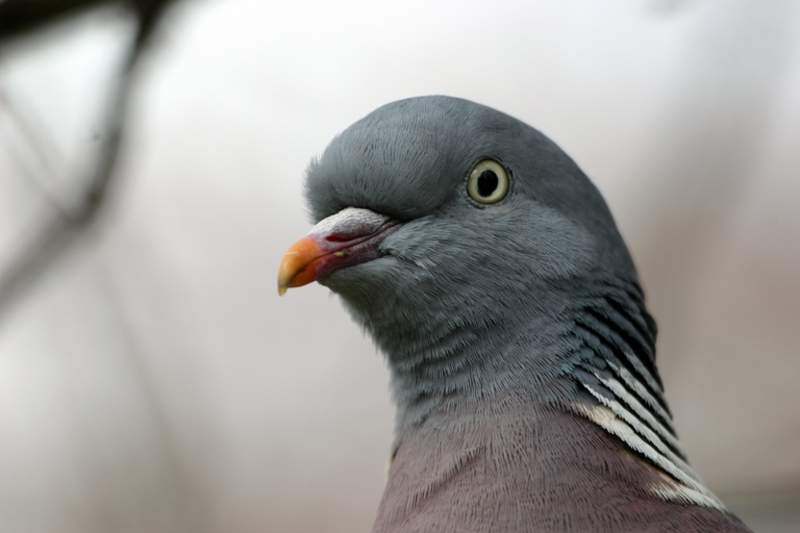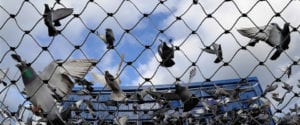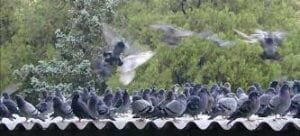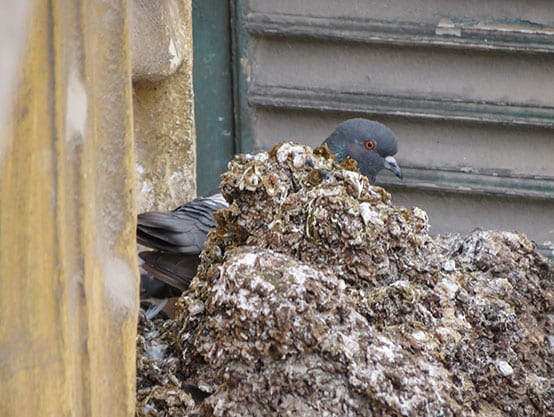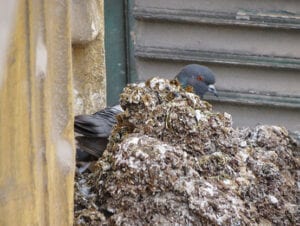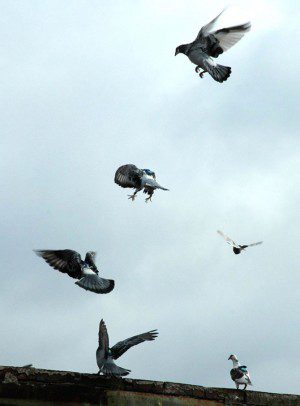
A Bone To Pick: Why Do Pigeons Eat Fried Chicken on the Street?
Poor urban pigeons, they’re raised in the slipstream between double decker buses tumbling along ancient, polluted roads, feeding on grains, bread and whatever else is flung their way. They’re too inedible to fall under the remit of the Game Farmers Association (GFA), and they’re too abundant in cities to be important to the Royal Society for the Protection of Birds (RSPB) meaning they receive no ecological protection. Besides, most of us see them as a blight of flying rats. So they are left to fend for themselves, living in a kind of Dickensian dystopia, thriving on the rubbish the rest of us throw away.
This hunt for survival has taken an unseemly turn. If you live in a city, you will probably have seen it a hundred times, maybe without even thinking about it: pigeons eating chicken bones. They feast on discarded boxes of chicken and chips like they were a Serengeti watering hole, prodding, pecking and poking at the innards of its carcass. They gorge on its flesh near-cannibalistically, before flinging its bones like majorettes twirling batons.
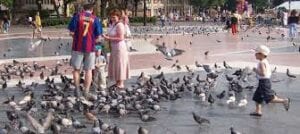
I know we all hate pigeons, but that can’t be good for them, can it? Aren’t they supposed to be herbivores? A spokesperson for the GFA, which focuses on breeding wood pigeons to make them hunt-ready tells VICE: “I certainly haven’t heard of pigeons eating chicken bones. Pigeons, like doves and all of those sorts of birds, are not meat eaters. But urban pigeons are very different to the ones we get in the countryside.”
The feral pigeon, these mongrel bastard birds, have fallen through the cracks. So I turned to the British Trust for Ornithology’s spokesperson and ornithologist himself, Paul Sandcliffe, in the hopes he might know a bit more about why a herbivore bird would want to feast on chicken bones.
VICE: Hi Paul. Why do you think pigeons might eat bits of chicken bones? Are they just feral compared to their rural cousins?
Paul: When we get back to basics, urban pigeons are not that different to rural pigeons, they will feed in large flocks, and once one pigeon is on the ground, it will attract other pigeons. The major difference between these birds, though, is their diet. Rural pigeons are looking for large seeds or cereal grains like rapeseed which are high in energy and can actually fill them. Whereas urban pigeons are just looking for any food that’s available and will test out anything.
So when they’re pecking the chicken they’re just trying it out?
Yes. Pigeons aren’t carnivorous but they’ve come across this potential food, they’ve checked it out, and if it’s edible, they’ll eat it.
Is it possible that the way fried or marinaded chicken is cooked; in flour and batter and sauces makes it less like chicken and more appealing to the pigeon?
I think the big thing making this chicken appealing to the pigeon is that it’s cooked. Lots of birds aren’t specifically carnivorous but if they come across a dead bird they’ll have a peck at it and take some of the meat. I’ve seen it in footage of coal tits in Northern Scotland, pecking at a deer carcass. They can do it because, ostensibly they’re insectivorous [vegetarian except for insects], so they do have this element of a carnivorous diet. But pigeons are granivorous [grain-eating] so their beak is designed for grains. If they come across a corpse they just can’t deal with it; the skin’s too tough to peck through. But if the corpse has been cooked then the texture is soft. So they can peck at it and bits come away. They’re probably not even thinking of it as meat if they’re thinking at all. It’s just food.
Let’s say a pigeon managed to eat a chicken nugget’s worth of chicken, though. Is that any good for its digestion?
I’m not particularly sure there would be a negative impact. Really? But it sounds so gross.
Birds, by their very physiology, won’t eat more than they should eat. Pigeons can’t afford to be fat because it affects their weight and then they can’t fly. And when they can’t fly it makes them vulnerable to predation
Do pigeons actually go through that thought process? Or do they simply stop when they’re full?
It’s just nature for them to stop when they’re full. You could give a blackbird a bucket of worms and it will only eat the amount it needs to survive in that moment and still make a quick escape if needs be. Same goes for a pigeon.
That’s smart. A farmer once told me that chickens will eat concrete to get the right nutrients to make its eggs. Is there any chance pigeons are eating chicken bones to get the right nutrients to make their own eggs?
Female pigeons will be looking for a source of calcium and calcium is hard to come by. They do eat grit and small stones so they probably get a little bit of calcium that way. It’s not impossible that they could eat bones too. I have a wildebeest skull on the shed at the bottom of my garden and over time, the bone has started to break down and become porous and soft inside. Now the blue tits are coming and taking bits of that skull as a source of calcium. I’ve never seen pigeons on that skull, but it’s probably because they’re not agile enough to get up to it. They have to find sources of calcium somewhere, so it could be that the small pieces of bone on the chicken provide that.
So they’re not gross for eating chicken, just resourceful?
All a bird does all day every day is search for food because they can’t have a big breakfast and be done with it. They have to eat small amounts throughout the day. So they’re spending all day every day looking for food and that includes checking out bits of chicken.
Pigeon Patrol Products & Services is the leading manufacturer and distributor of bird deterrent (control) products in Canada. Pigeon Patrol products have solved pest bird problems in industrial, commercial, and residential settings since 2000, by using safe and humane bird deterrents with only bird and animal friendly solutions. At Pigeon Patrol, we manufacture and offer a variety of bird deterrents, ranging from Ultra-flex Bird Spikes with UV protection, Bird Netting, 4-S Bird Gel and the best Ultrasonic and audible sound devices on the market today.
Voted Best Canadian wholesaler for Bird Deterrent products ten years in a row.
Contact us at 1- 877– 4– NO-BIRD, (604) 585-9279 or visit our website at www.pigeonpatrol.ca
Pigeon/Pigeon Patrol / Pigeons Roosting / Vancouver Pigeon Control /Bird Spikes / Bird Control / Bird Deterrent / Pigeon Deterrent? Surrey Pigeon Control / Pest /Seagull deterrent / Vancouver Pigeon Blog / Birds Inside Home / Pigeons in the cities / Ice Pigeons/ What to do about pigeons/ sparrows , Damage by Sparrows, How To Keep Raccoons Away, Why Are Raccoons Considered Pests/ De-fence / Pigeon Nesting/ Bird Droppings / Pigeon Dropping/ woodpecker control/ Professional Bird Control Company/ Keep The Birds Away/ Birds/rats/ seagull/pigeon/woodpecker/ dove/sparrow/pidgeon control/pidgeon problem/ pidgeon control/flying rats/ pigeon Problems/ bird netting/bird gel/bird spray/bird nails/ bird guard

